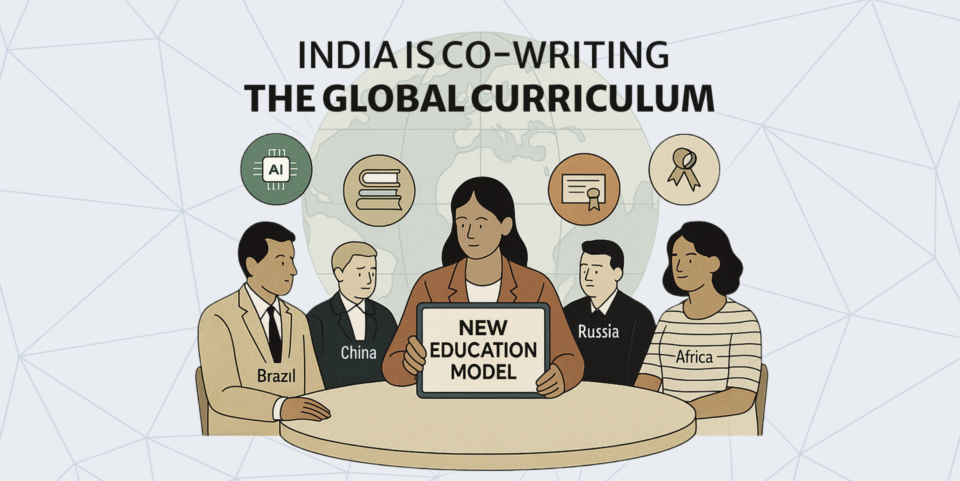
A Blueprint for Branding Excellence-More about the G20 5C Framework
Maghan Varkey, Director- Edunoia
The recent G20 summit convened in Delhi witnessed the unveiling of a visionary framework poised to overhaul our perceptions and methodologies in education.
It is not just about 'state-of-the-art' infrastructure; it is about purposeful architecture that promotes collaborative environments and makerspaces.
This comprehensive approach to education reform brings to light several key implications for educational brand consultants.

During the G20 Education Ministers Meeting, our Prime Minister Shri Narendra Modi delivered a video message:
"Education is not only the foundation upon which our civilization has been built, but also the architect of humanity's future. As Education Ministers, you are the Sherpas leading mankind in our efforts for development, peace, and prosperity for all. In Indian scriptures, the role of education has been described as being key to bring joy."
In a pivotal moment on the global education stage, the recent G20 summit convened in Delhi witnessed the unveiling of a visionary framework poised to overhaul our perceptions and methodologies in education. Termed the "5C Framework," this comprehensive roadmap for educational reform addresses five pivotal dimensions: Coordination and Leadership, Content and Curriculum, Connectivity and Infrastructure, Capacity and Culture, and Cost and Sustainability.
Coordination and Leadership: Leading the Way
It is no secret that educational institutions often grapple with bureaucracy and hierarchical decision-making structures, making it challenging to implement solutions for current students or even engage with prospective ones. The first pillar of the 5C Framework, Coordination and Leadership, is vital for effective educational reform. In line with Chapter 19 of the National Education Policy (NEP) 2020, strong governance and leadership, marked by merit-based appointments and alignment with constitutional values and the institution's vision, are essential for fostering a culture of excellence and innovation in higher education institutions.
Content and Curriculum: Pioneering Excellence
The second 'C' in the framework, Content and Curriculum, emphasises the need to be at the leading edge of knowledge. Government institutes and state-affiliated universities are often criticised for perceived lagging, but the case of G H Raisoni College of Engineering (GHRCE) challenges this stereotype head-on.
GHRCE, an Autonomous Institution affiliated with Rashtrasant Tukadoji Maharaj Nagpur University, made a significant impact by introducing a B.Tech. program in Artificial Intelligence, becoming the second institution in India to do so. This pioneering move occurred four years before the widespread recognition of AI's current relevance. The program's educational objectives aim to produce knowledgeable Machine Learning engineers capable of contributing effectively to the advancement of Intelligent Computing systems.
GHRCE's proactive approach has not only transformed its students into forward-thinking leaders but has also repositioned the institution's standing. It serves as a compelling example highlighting the importance of content and curriculum development.
Connectivity and Infrastructure: Enabling Collaboration
The third pillar, Connectivity and Infrastructure, acknowledges that modern education extends beyond physical facilities. The Stanford Design School, known as the D-School, serves as a global model for cultivating collaborative environments.
Dean Sarah Stein Greenberg of Stanford D-School explains, "At the D-school, we focus on 'setting the conditions for creativity to emerge.' It is about arriving at the moment with trust, materials, and a well-framed problem, which allows meaningful progress in a creative way."
Stanford's commitment to connectivity, both in physical and digital realms, has redefined its educational landscape, providing students with the necessary resources for innovation. It's not just about 'state-of-the-art' infrastructure; it is about purposeful architecture that promotes collaborative environments and makerspaces.
Capacity and Culture: Nurturing Excellence
The fourth 'C,' Capacity and Culture, delves into an institution's essence, encompassing what it is known for and the culture it nurtures.
A prime example of how a distinctive culture can shape an institution's brand is Kellogg School of Management at Northwestern University. Kellogg, renowned for its dispute resolution expertise, stands as a thought leader in this area. On the other hand, in the Indian context, Bennett University's commitment to social responsibility serves as a noteworthy case.
This underscores the necessity for unique Employee Value Propositions (EVP), which are instrumental in drawing faculty and staff who share the institution's values.
Cost and Sustainability: The Crux
The ultimate 'C' in the framework, Cost and Sustainability, delves into the financial dimension of education, underscoring the challenge of balancing cost-effectiveness with the imperative of sustainability.
In this evolving learner-centric ecosystem, the cost of education has been steadily increasing, rendering higher education an unaffordable luxury for many. To address this issue, some higher education institutions are harnessing learning technologies to establish online universities capable of providing experiential learning opportunities at a more accessible cost. This approach could act as a promising avenue to make education financially sustainable and inclusive in an era of rising expenses.
What this essentially implies for Brand Consultants:
The introduction of the G20's 5C Framework in education marks a significant turning point for brand consultants operating in this space. This comprehensive approach to education reform brings to light several key implications for educational brand consultants. Brand consultants must now align their strategies with the 5C Framework, helping educational institutions showcase their strengths in coordination, content, connectivity, capacity, and cost-effectiveness.
The journey toward educational excellence and innovation has just begun, and the world is watching with great anticipation.



































